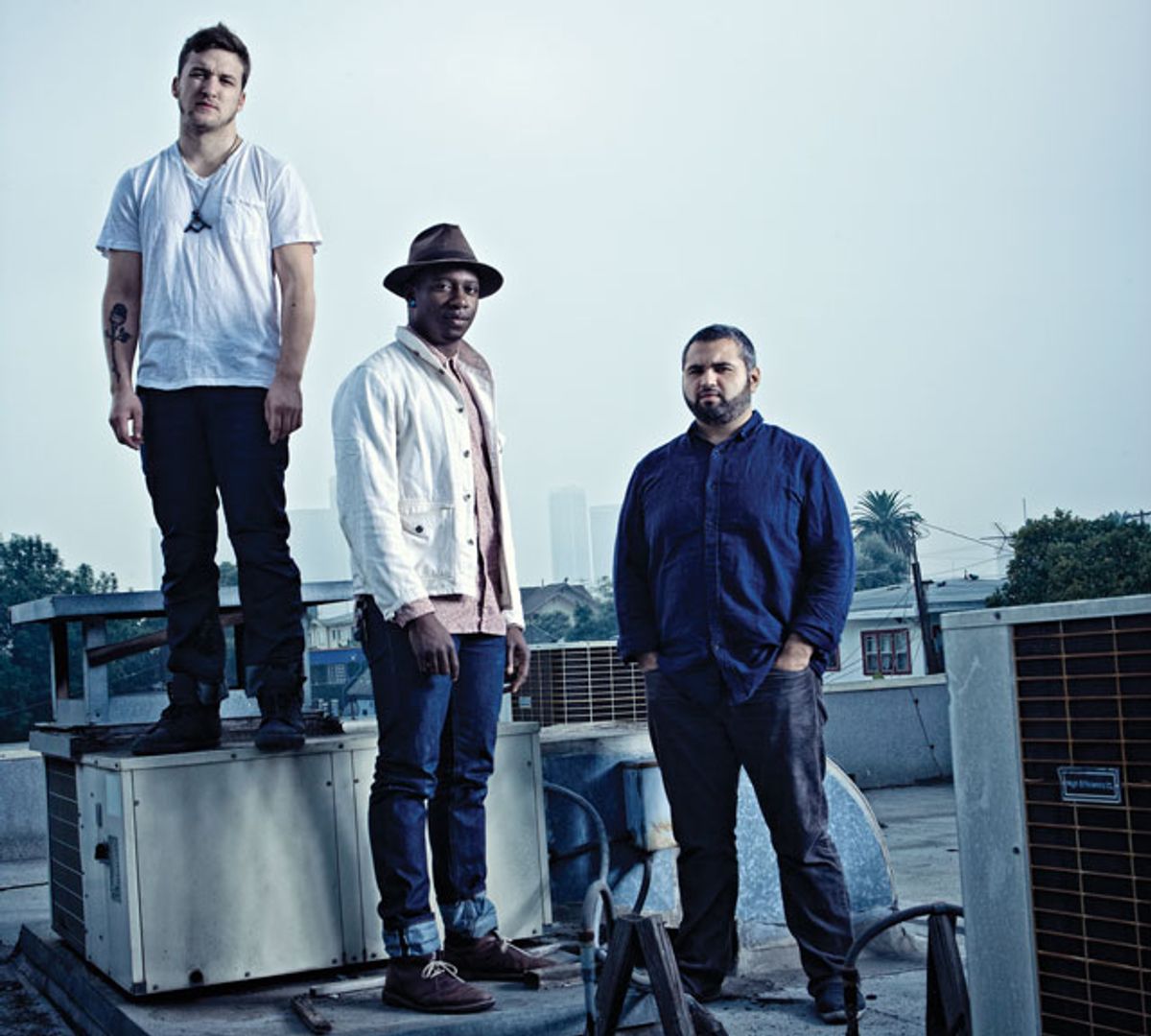Tosin Abasi and Javier Reyes—Animals as Leaders’ jaw-dropping dualguitar team—live up to their name and create a new progressive-rock beast by cross-breeding jazz, classical, and metal techniques in a way that simultaneously blows your mind and defies the genre’s stereotypes.
“It’s a few genres combined into one. It’s like progressive metal, progressive jazz … space metal,” says Tosin Abasi, founder of Animals as Leaders, when pressed to pigeonhole his band into a category. And he’s right—in the course of a single AAL song, your ears might be assaulted by math-metal djent-isms with bittersweet Lydian sonorities, tapped open-voice triads, contrapuntal textures, 8-string slapping and popping that sounds like a cross between Victor Wooten and Eddie Van Halen’s “Mean Street,” and lo-fi electronica-influenced tones.
On the surface, this description of AAL’s musical mélange might reek of the sort of music-school pretension you expect from guys who wear Jaco Pastorious T-shirts and throw in every new device they learn in theory class to create a hodgepodge of faux eclecticism. But Animals as Leaders weaves every twist and turn so organically that it never sounds forced and, after a couple of listens, almost doesn’t make sense any other way.
Many got their first introduction to Abasi’s virtuosic style on Animals as Leaders’ self-titled 2009 debut, which garnered intense praise from fans like Steve Vai. Explaining its unusual origins, Abasi says, “That album was essentially a studio project done with [Periphery guitarist] Misha Mansoor and myself. There was no band present.” In contrast, Animals as Leaders’ latest release, Weightless, which made it to No. 1 on the Amazon metal charts and hit No. 80 on the Billboard Top 100—no small feat for an all-instrumental act—marks the change from a studio effort to a real band. Abasi recruited 8-string guitarist Javier Reyes and drummer Navene Koperweis to flesh out the lineup. If you’re wondering why another 8-string slinger, rather than a bass player, was brought into the band, Abasi explains, “I’ve written music with Javier before. He’s one of a few guitar players I’ve actually had an effortless sort of rapport with. He’ll always think of different ways to complement what’s already there. For instance, he has a good handle on diatonic chord harmonies, so he’ll invert the chords that I’m doing.”
Animals as Leaders is perhaps the most groundbreaking progressive metal band of the current generation. In fact, it’s probably safe to say that they’re the genre’s game-changer. One of the secrets to their success is the accessibility of their music. Unlike some progressive bands that play epics with so many sections that you need to pop a couple of Ritalins to keep focused, AAL keeps things pretty concise. The longest cut on Weightless clocks in at a mere 5:16. Asked about this, Abasi says, “The songs on the new album are shorter— usually just three to four parts per song. It was more about taking a look at the fact that we don’t have a singer, and thinking of what would really ingrain these compositions in the listener’s brain. We wanted to trim the fat and distill each song to its essential parts.”
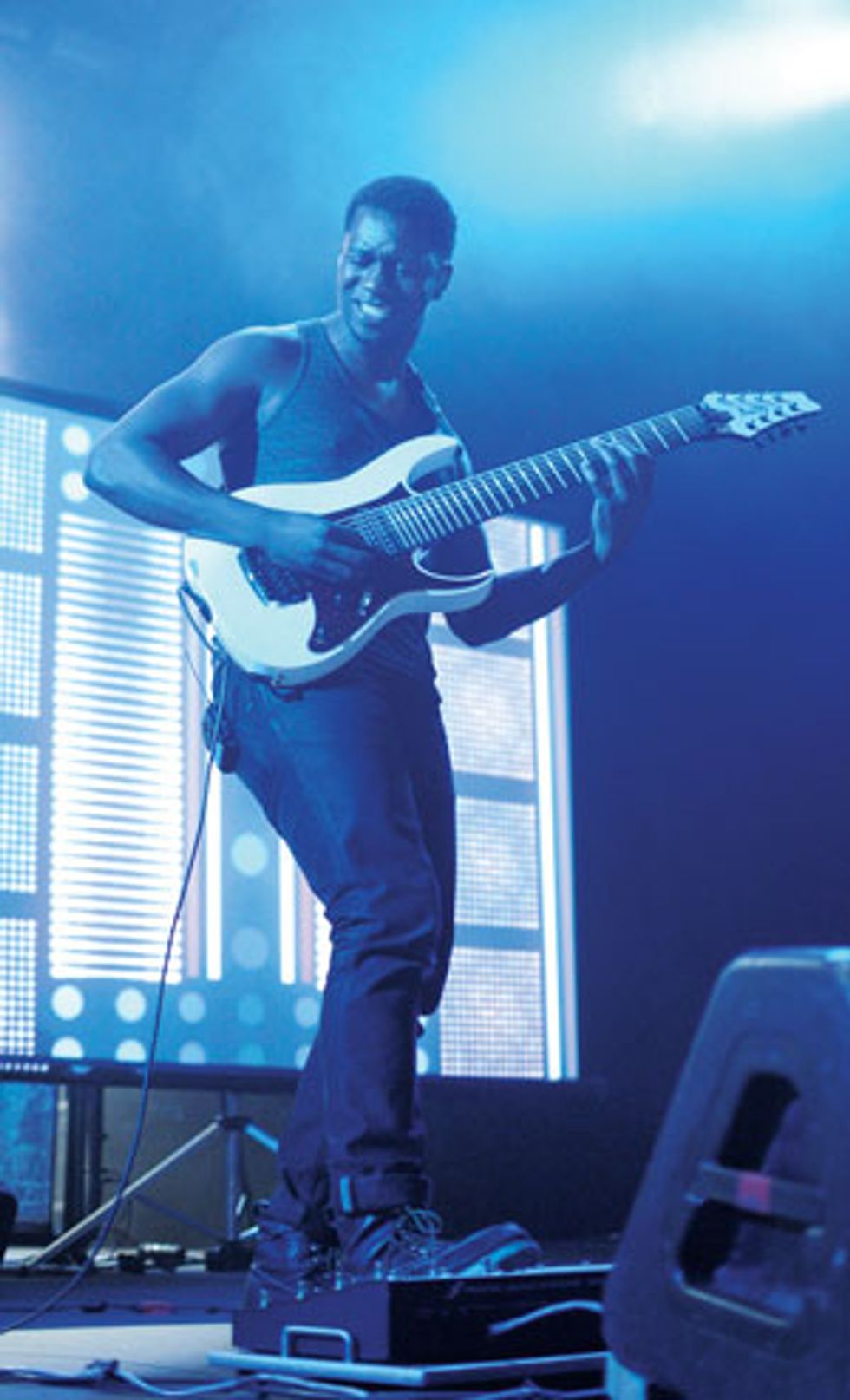 Guitarist Tosin Abasi
turning heads with
his tapped 32ndnote
flurries at a gig
in NYC on December
11. Photo by Sam
Charupakorn
Guitarist Tosin Abasi
turning heads with
his tapped 32ndnote
flurries at a gig
in NYC on December
11. Photo by Sam
Charupakorn Here, Abasi and Reyes talk about what set them on their unique paths and what they used to conjure the plethora of tones on Weightless.
How did you guys learn to play the
guitar—lessons, books, or by ear?
Abasi: I was self-taught. I was never that
good at really figuring out what someone
was doing and reproducing it. What I
would do is turn on the radio and improvise
over whatever was on. Inadvertently,
I was learning, “I can use Dorian over this
song or Mixolydian sounds cool here.” I
would wear out my REH or Hot Licks
videos of guys like Paul Gilbert and Frank
Gambale, learning the licks and some of
the concepts. That’s how I basically played
for 10 years or more. Then I went to a oneyear
music program at the Atlanta Institute
of Music in 2005. That’s the extent of my
formal music education.
That’s not too long ago. I’m guessing you
probably could already play pretty well
by 2005.
Abasi: The chops were already there. Music
school was more for learning chord construction
and understanding how to work
in a key, as well as learning jazz standards
and classical guitar stuff.
How about you, Javier?
Reyes: I had a number of teachers, all at this
one store. My main teacher has been Julio
Sosa. He lives in Washington, D.C., and is
relatively unknown but is phenomenal. He’s a
master of his craft. I started with him when
I was probably 11 or 12 and continued until
I was 15 or 16. Probably about six or seven
years ago, I started studying with him again
and almost became his apprentice, if you
will. I took it to a way more serious level.
Were you also into rock or was it classical
right off the bat?
Reyes: Well, it was a little of both. My first
teacher was a flamenco teacher but then
maybe a year after, my older brother was
playing the electric guitar—so I also wanted
to do it. I started learning Beatles and
Rolling Stones stuff. Then I started with
Julio Sosa and stuck with the nylon-string
for a while. I always played 7-string electric
on my own. I was into metal and listened
to Pantera and Dream Theater and stuff
like that. I was always looking for bands
that highlighted guitars—a little bit of
everything … classic rock, Judas Priest.
What were you listening to growing up,
Tosin?
Abasi: Before I got a guitar, it was whatever
was on the pop charts, like Guns N’
Roses and Michael Jackson. I got a guitar
when I was 12, during the beginning of
the whole alternative scene, so it was a
lot of Nirvana, Smashing Pumpkins, and
Soundgarden. My older brother was playing
drums at the time, and he had better
taste than me. He got a lot of the Modern
Drummer Festival videos, which had really
technical players. That was the gateway
into bands like Dream Theater.
Let’s fast-forward to today. Are the solos
on the album worked out or improvised?
Abasi: They’re actually improvised until
they’re composed. I’ll play the solo section
over and over and flesh it out, throwing in
a few different ideas and angles of approach
until I figure out something that’ll work,
and then this will end up being the composed
solo. I feel like I’m going to get a better
solo that way. The solo sections for some
of the compositions are hard. You don’t get
a whole lot of choruses to really develop
your solo or anything like that. It’s like one
time through, usually at a very rapid tempo
and in an odd meter. That’s not my ideal
improvisational setting and not where I
feel too comfortable improvising.
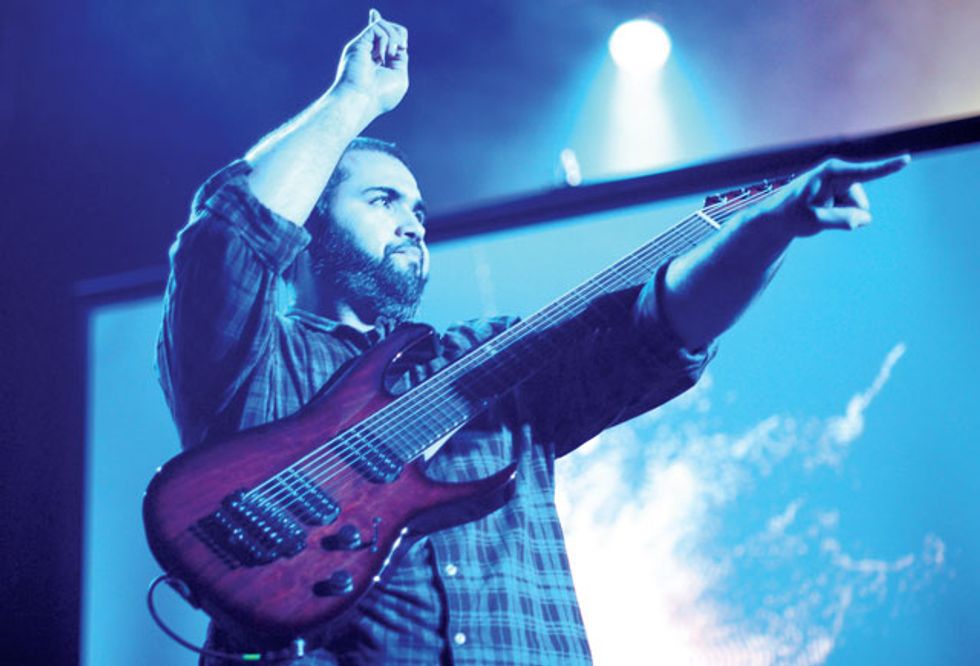 Javier Reyes asks a
soundperson to crank
up his Ibanez RGA
in the mix. Photo by
Sam Charupakorn
Javier Reyes asks a
soundperson to crank
up his Ibanez RGA
in the mix. Photo by
Sam Charupakorn
Do you use notation or charts to communicate
the band’s music?
Abasi: I read at a very basic level, but it’s
kind of de-motivating so I avoid it. We
don’t use charts or notation—everyone
basically plays by ear. A lot of the stuff
is very technique oriented, so I’ll have to
physically show Javier what I’m doing.
We record the music first, so the song
basically exists before we learn it as a
band. Then we go and learn our individual
parts. After the riff is tracked, Javier
will listen to it and either learn it by ear,
or if he had any questions, I’d clarify.
Reyes: For my own personal practice, a lot of times I’ll play along to the song. I’ll take sections and analyze them, count them out if I need to, and make my own little cheat sheet with the counting—but not necessarily in staff form. I’d just write [something like], “There’s three beats here, then a two-beat rest, then Navene’s going to do a two-beat roll.” I rely on a lot of muscle memory and intuition.
Abasi: We’re really heavy on phrase memorization. I don’t want to make any riffs that are so counter-intuitive that you have to count seven 16th-notes. We use the meters as a guideline, like, “Dude, you’re playing an extra beat because this is in 9/8.” We’ll do stuff like that, but at the end of the day it’s about internalizing the phrase of the musical line. I think that’s the best way to approach this stuff.
You guys play a lot more counterpoint
than many of your peers.
Abasi: Yeah, I’m an intermediate classical
guitarist—if I can even call myself that—
so it’s kind of a by-product of knowing a
bit of classical and then trying to utilize
its strengths. On an 8-string guitar, if you
drop the pick and use your open right hand,
you can play multiple lines at one time, basically
like playing classical guitar.
Reyes: I’ve been doing the classical and counterpoint stuff for a while, so learning Tosin’s stuff didn’t seem like a big deal. It’s allowed me to learn all this stuff.
In some ways, you guys are like an electric
version of the Assad Brothers classicalguitar
duo.
Reyes: Yeah, Tosin and I actually saw them
a while ago. I got introduced to the Assad
Brothers through my teachers back in D.C.
Abasi: Their harmonic approach is a bit more varied and adventurous than most traditional classical music. They’re technically proficient, too, which is obviously really nice. So, yeah, there are some parallels. Seeing them live was, like, “I didn’t know you could play at that speed with that amount of dynamics and detail!” It was phenomenal.
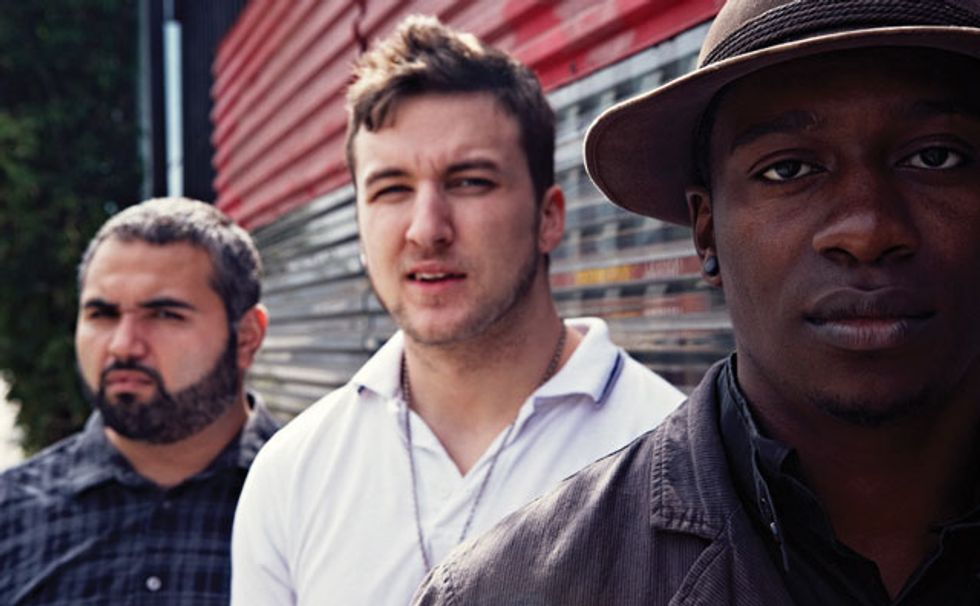 AAL is guitarists Javier Reyes
(left), Tosin Abasi (right), and
drummer Navene Koperweis.
Photo by Jonathan Weiner
AAL is guitarists Javier Reyes
(left), Tosin Abasi (right), and
drummer Navene Koperweis.
Photo by Jonathan Weiner
Do you guys still woodshed for hours
on end?
Reyes: Tosin is definitely more of a speed
shredder, doing all this crazy technique
stuff. I’m kind of just playing the parts that
need to be played.
Abasi: On tour, there’s a lot of song maintenance, and then I do general things that keep me limber. I’ve got a hybrid-picking book [that I study], which is basically chicken-pickin’, but it’s not about country music. The book has lots of permutations of left-hand fingerings. It’s all chromatic, four-frets-in-a-row stuff, but they’re dispersed in these sort of mathematical permutations.
Is the book you’re referring to Hybrid
Picking for Guitar by Gustavo
Assis-Brasil?
Abasi: Yeah, it’s a good book. I got his first
hybrid-picking book when I was in music
school, and two Animals as Leaders songs are
inspired from those exercises. That stuff is useful,
even if you’re just writing lines. The first
half of it is just these atonal permutations,
which is nice because you can turn them into
whatever scales or modes you want to use.
In songs like “Somnarium,” among others,
it sounds like you’re drawing from
the modes of the melodic minor scale.
Abasi: Yeah, that’s exactly right.
In metal, you sometimes hear harmonic minor
and diatonic modes, but not
too many people in the genre explore
melodic-minor modes—which are more
common in jazz-fusion—to the extent
you guys do.
Abasi: When I was in music school, we
covered all the modes—major and minor
scales—but then we went into harmonic
minor and melodic minor. That’s where
my ear started to peak, because you get
the intersection of a major seventh and a
minor third in the same arpeggio, which is
pretty cool. We have all these colors available.
Most tonalities are pretty directly
uplifting or diminishing, but with some of
the modes of these obscure scales it’s definitely
like a sweet-and-sour situation. I’m
kind of obsessed with these tonalities that
kind of blur the lines.
 The calm but
deadly Reyes
catches a groove
at NYC’s Best
Buy Theater.
Photo by Sam
Charupakorn
The calm but
deadly Reyes
catches a groove
at NYC’s Best
Buy Theater.
Photo by Sam
Charupakorn
Javier, when Tosin uses an unexpected
scale or plays sort of atonal, does that feel
natural to you or do you have to acclimate
your ear to it?
Reyes: A little bit of both. If the rhythm
and the progression aren’t too crazy, I can
find a melody somewhere in there. I like
to look for melodies that lead you somewhere
else—shifting around in modes and
things—but I’m not actually paying attention
to that sort of stuff. After the fact I can
say, “I guess I’m in Lydian” or whatever.
“David” has a great ethereal vibe and
some really nice interplay between the guitar
parts. Did you write that one together?
Abasi: No. I just used my ear and little bit
of theory to come up with the second part.
“David” is actually inspired by Gustavo’s
book as well. I was working on an exercise
and thought, “Wow this is really cool.” I
just changed some intervals, changed the
rhythm a bit, looped the main theme into
my Boomerang [Phrase Sampler pedal], and
then messed around with another part—I
think it was an inversion of the same chord.
Let’s talk about gear now. You guys are
Axe-Fx users, right?
Abasi: Yeah, we’re using the Fractal Audio
Systems Axe-Fx II, and that houses all the
effects, as well as our amp tones. It’s a simulator,
so we just go directly back into the PA.
Reyes: We have absolutely no amps onstage.
What about guitars?
Reyes: I use Ibanez RGA8s. One is stock,
and the other is a custom with a bubinga
top and an ash body, but with pretty much
the same specs as the stock one.
Abasi: I have quite a few custom Ibanez guitars— all are 8-strings. I have a hollowbody 8-string that was made just for me, and it’s unique because it’s actually a neck-through design with hollow wings. It’s an [Ibanez] RG shape with a slight arch to the top, but I cut an f-hole in it so it looks like a semi-acoustic instrument. I also have a handmade guitar from a luthier named Ola Strandberg. It’s very unique—the neck profile is actually an asymmetrical trapezoid, so it’s thinner on the treble side, and it expands on the bass. It’s a fanned-fret guitar, too, so it’s multi-scalar.
What are the advantages of the fanned frets?
Abasi: Basically, there are certain pitches
that should exist within a certain scale
length. Once you start to go into bass territory,
you benefit from a longer neck just for
temperament or tension. So the multi-scale
[neck] combines a longer scale for your bass
notes and a shorter scale for your treble
notes, and what you get is a progressively
slanted sort of fretboard. That way, you
don’t have a neck that’s super long for your
treble strings—which makes the timbres
sound unnatural or the tension too high—
and you get enough tension for the lower
strings. You get the best of both worlds.
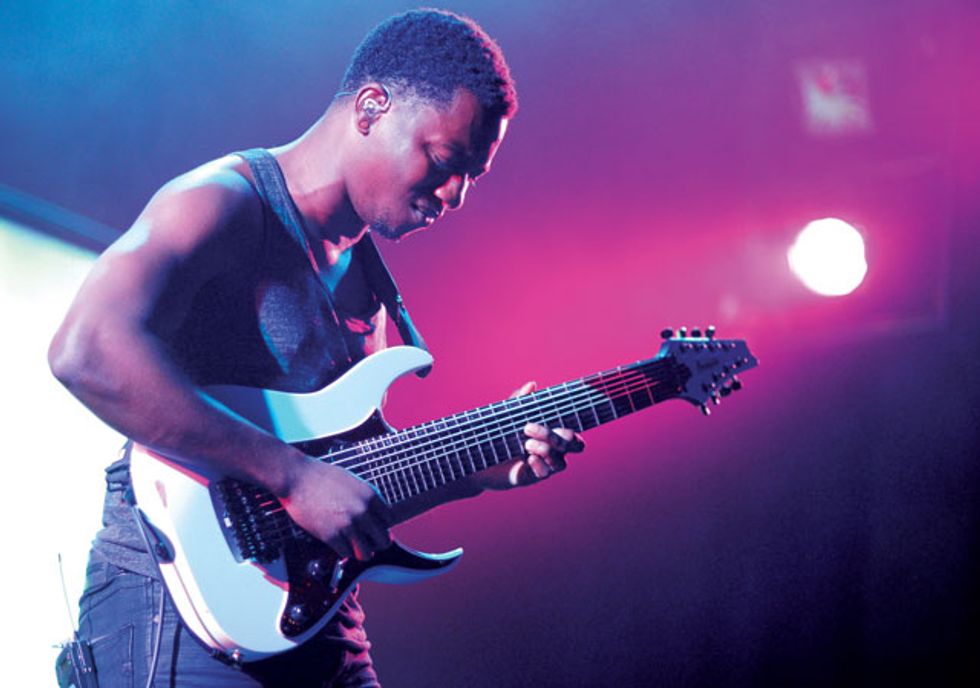 Abasi tearing up “An Infinite
Regression” with one of
his custom Ibanez 8-strings.
Photo by Sam Charupakorn
Abasi tearing up “An Infinite
Regression” with one of
his custom Ibanez 8-strings.
Photo by Sam Charupakorn
In addition to having fanned frets,
your Strandberg is also headless. Do you
think headless guitars will ever make
a comeback, or will they always be
a niche thing?
Abasi: It’s hard to tell, because I don’t
really think like a normal guitarist. There
are a lot of traditionalists who say they
wouldn’t ever play active pickups or
who think a guitar should only have six
strings. So a headless guitar is a turnoff
to someone who’s really into Fenders or
something. Beyond writing progressive
music, I’m pretty progressive minded in
general. I really like for things to evolve,
because that usually means the design is
being refined and actually making our job
easier. So I would love to see more builders
taking a completely objective approach
to guitar building as opposed to relying
on tradition 100 percent.
Speaking of being progressive, I’m guessing
that knowing what you’re listening to
now might hint at what’s to come in the
future. Who are your current influences?
Reyes: I take ideas from classical guitarists
like Agust’n Barrios, as well as more modern
artists like Dirty Projectors and different
electronic DJs. I listen to their sound
design and how they produce.
Abasi: Jimmy Herring’s a recent discovery. He gave master classes at the music school I went to. He’s got a lot of hip, melodic ideas that are totally taken from bebop but he’s not playing straight-ahead jazz. He’s got a great sort of blues element to all of it. I’m also into jazz guitarists Kurt Rosenwinkel and Adam Rogers, as well as bass players like Matthew Garrison. I just found a really old John Scofield master class, and the playing on it is just phenomenal— really cool ideas. So, apparently now I’m a Scofield fan.
It’s interesting that you mention
Rosenwinkel and Rogers, because the
clean interlude at 1:41 in “Somnarium”
sounds like something Ben Monder,
another modern jazzer, might write.
Abasi: Ben Monder, yeah he’s very cool and
has a very bold sense of harmony. It’s cool
that you’re bringing up all these players,
because these are the guys that I’m listening
to who are really inspiring me to push the
melodic envelope. But when it arrives in
metal, it sounds even more striking because,
like you said, there are some decided tonalities
that are expected.
Would you ever go in a jazzier direction?
Abasi: Those guys have been influential in
terms of the chord voicings that I use and
the melodic blends I’m trying to create—it’s
just ending up in this sort of metal context.
Would I ever go that complete route? I’m
not the improvisational player that those
guys are, but I think that part of my brain
always wants to be part of that world to
some degree. The music is definitely really
compelling and stimulates my creativity,
but I’m not necessarily concerned with
straight-ahead jazz as a genre or post-bop or
whatever you want to call it.
Reyes: Just knowing Tosin’s personality, he’s all about just writing whatever he wants to hear. How we grow as musicians is how the next album is going to progress. If it tends to be jazzier [than the past], then that’s what it is. If it tends to be more metal, then that’s what it is.
Javier Reyes' Gear
Guitars
Ibanez RGA guitars with DiMarzio
D Activator 8 pickups.
Effects
Fractal Audio Systems Axe-Fx II
controlled by Fractal MFC-101 MIDI
foot controller.
Strings and Picks
DR .010 sets with a .060 seventh
string and an .080 bass string for
8-string standard tuning (with the
eighth string tuned down to low E),
Jim Dunlop .60mm picks.
Tosin Abasi's Gear
Guitars
Ibanez RG2228 with EMG 808X
pickups, Ibanez custom 8-string
hollowbody, Ola Strandberg custom
8-string with fanned frets.
Effects
Fractal Audio Systems Axe-Fx II
controlled by Fractal MFC-101
MIDI foot controller,
Boomerang Plus phrase sampler.
Strings and Picks
DR .010 sets with a .060 seventh
string and an .080 bass string for
8-string standard tuning (with the
eighth string tuned down to low E),
Jim Dunlop .60mm picks.
Youtube It
For an up-close look at Animals as Leaders’ instrumental
prowess, check out the following clips on YouTube.com.
Dig an entire Animals as Leaders concert
from Kosmonavt in St. Petersburg, Russia,
on September 29, 2011.
Animals as
Leaders “Cylindrical Sea” LIVE 11/8/11
in Indianapolis IN
Abasi employs unorthodox techniques
to create an otherworldly effect at the
House of Blues in Houston, Texas, on
November 17, 2011.
